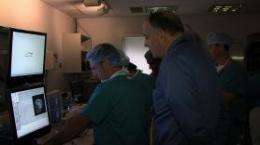Physicians use minimally invasive laser surgery for epilepsy

(Medical Xpress) -- The procedure this week at UAMC was the first of its kind performed in Arizona.
Physicians at The University of Arizona Medical Center-University Campus this week became the first in the western U.S. to operate on an adult epilepsy patient with minimally invasive MRI-guided laser surgery – a safer, less-invasive alternative to opening the skull and cutting out the brain tissue where the disorder originates.
A 48-year-old Tucson man underwent the MRI-guided laser surgery on May 29 at University Campus and was released the following day. Two other patients are scheduled to have the surgery in the next month.
Epilepsy is a disorder in which surges of electrical activity in the brain result in seizures or loss of consciousness. About 3 million Americans are thought to have some form of epilepsy.
The disorder is usually controlled with medication. However, more than 30 percent of people with epilepsy do not have seizure control even with medication and, until very recently, major brain surgery or implantation of a device have been their only treatment options.
Minimally invasive laser surgery to treat epilepsy was first used late in 2010 at Texas Children's Hospital in Houston, which reported excellent results on six pediatric patients. A similar surgical technique has been used successfully for more than a decade to treat certain brain tumors.
"This promising procedure has worked very well elsewhere and we are excited to offer it in Arizona," said neurologist Dr. David M. Labiner, who heads the department of neurology and the Arizona Comprehensive Epilepsy Program at UAMC.
"It's low-risk and far easier on patients than traditional brain surgery. We're optimistic that it will become the treatment of choice for adults and children with epilepsy that does not respond to standard medical treatments."
During the procedure, neurosurgeons Dr. Martin E. Weinand and Dr. J.P. Langevin of the UA department of surgery, working alongside a team of neurologists who make up the Arizona Comprehensive Epilepsy Program of the UA department of neurology, placed a thread-like laser applicator into the patient's brain.
Then the physicians used MRI to visualize epileptic areas inside the patient's temporal lobe and guide a thermal laser to heat and destroy them.
"The surgery is exquisitely precise. With this technique we're able to remove only the areas associated with seizures and spare healthy brain tissue only a hair's breadth away," Labiner explained. "The therapeutic effect is immediate for the patient. When the lesions are destroyed, the seizures end."
"The Division of Neurosurgery at the University of Arizona is constantly seeking to develop and employ new methods and techniques that minimize our surgical footprint while retaining maximal effect. Dr. Weinand and Dr. Langevin's recent success demonstrates our highest commitment to advancing patient care through research. This form of less-invasive epilepsy surgery may one day become a standard tool in our arsenal," said Dr. G. Michael Lemole, Jr., chief of the Division of Neurosurgery.
Dr. Rainer W.G. Gruessner, professor and chairman, UA department of surgery, added, "Dr. Langevin was recruited to the Southern Arizona VA Healthcare System and The University of Arizona Medical Center to join Dr. Weinand in bringing this much-needed treatment option to Arizona."















